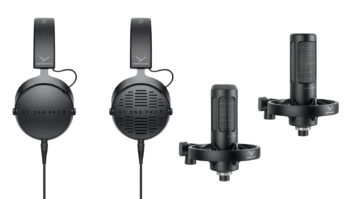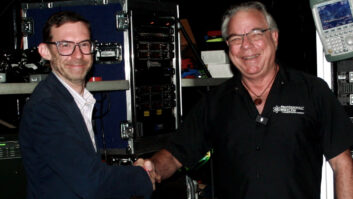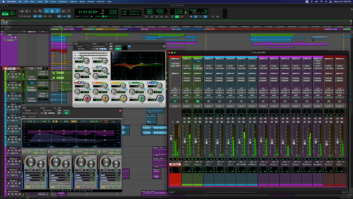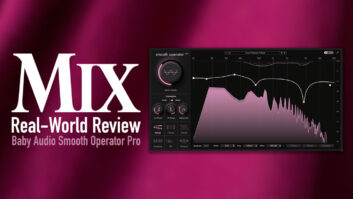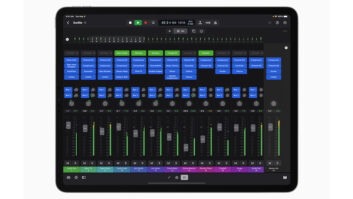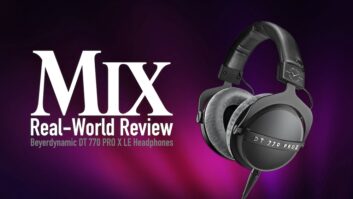
What will Canadian ingenuity and eight Danish transducers get you? One great-sounding surround recording system. The Holophone H2 Pro is the second incarnation of the company’s unique multichannel recording microphone. The unit uses eight DPA 4060 capsules mounted in an incredibly light “head” (L, C, R, Ls, Cs [center surround], Rs, VOG [top] and sub). The head is attached to a steel U-joint that swivels and locks via two hefty threaded knobs at the side. The 15-foot multicable is mounted with a sturdy and flexible rubber stress-reliever at the head and terminates to eight labeled XLRs. The DPA capsules can handle 134 dB before clipping with an equivalent noise rating of 23 dBa.
IN PRACTICE
I used the Holophone in a 5.1 recording of a percussionist. I regularly do this session with five front-address cardioid condensers set in an ITU array with a separate sub mic. The session is not the typical “live” setting: The drummer does five overdubs around the rig with various percussion, each to its own set of 5.0 or 5.1 tracks. For this test, I set up my usual ITU rig and floated the Holophone above the center position from above on a large boom. Then, I moved the mics out of the typical 30- (L/R) and 110-degree (Ls/Rs) positions to match the angles on the Holophone. Each set of mics had its own set of tracks cut to Pro Tools|HD at 88.2/24-bit resolution and were sent through the mic preamps on a Control|24. Playback was on five M&K MPS-2510P/K speakers and an M&K MPS-5410 sub.
I go through this setup quite often and was struck by how easy and light the Holophone was to use and set up. The U-joint is sturdy and easily adjusted for any desired orientation. The one thing I’d ask for is a bit more leeway through the “U” when orienting the mic with the cable above it to let the multicable pass through more easily. It’s quite sturdy, but I found myself having to “muscle” it more than I’d normally feel comfortable doing.
The percussionist first played a large cajón in the center position and then carried on around the rig, overdubbing bongos, hand percussion and dumbek until we completed all five passes. Afterward, I separately grouped the tracks for an easy A/B listening test. The results couldn’t have been more startling. The separate mics sounded good but very “separate,” while the Holophone sounded like the room. Of note was the difference in meter ballistics between the two sets: The Holophone’s off-axis feeds were much closer to the on-axis, while the separate mics were much farther apart.
On a lark, I used the Holophone as an LCR drum overhead in stereo, and also fed the Ls and Rs to separate tracks and brought them up as room mics in the mix. Although this is not its intended use, it’s a great way to record drums. The rendered stereo image across the front was remarkable. While experimenting with muting the center mic, I was surprised to discover how good it sounded with just the left and right. It worked in a number of ways and gave me a lot of options. The rears gave me an interesting L/R image of the drums in the room. Keep in mind that this is five mics set up and fed in less than five minutes. Try doing that with separate mics and stands!
The last recording test was also a stereo application, recording a Yamaha grand piano. The lid was up and the rig was placed about three feet back, pointing into the piano. It sounded wonderful, was easy to set up and the stereo image was brilliant.
Because I was concerned with the high noise figures associated with the DPA capsules, I took one of the mics and fed it through a GML 2032 mic preamp. The GML was incredibly clean, transparent and a good barometer of what was really going on in the noise floor of any mic. The noise was evident but not obtrusive — yes, there would be a multiplication of the effect with the addition of more capsules, but in my tests with percussion, piano and drums, it was not a problem. The one problem I did have was when I had to boost the internal sub mic through the Control|24’s mic preamp to attain sufficient meter level. They weren’t up to the job, having a noise floor of their own to add to the mix.
COMING FULL CIRCLE
The following anecdote sums up my Holophone experience the best: I set it up in the center of a large room, routed cables and brought the mic pre’s up to a general level to see if everything was working. The sax player for the upcoming session was off in the corner noodling on a Yamaha grand piano while someone came into the control room looking awestruck and said, “It sounds like he’s playing the piano in this room.”
It is a remarkable tool for capturing the realism of any recording environment. The DPA capsules render a fantastically clean picture. The product’s fit and finish is excellent, and it is a breeze to set up and position. Yes, the $6,000 price tag is steep, but if you’re looking for a great solution for compact, discrete recording at up to 7.1, the Holophone H2 Pro is a great choice.
Holophone, 416/362-7790, www.holophone.com.
Kevin Becka is Mix’s technical editor.
